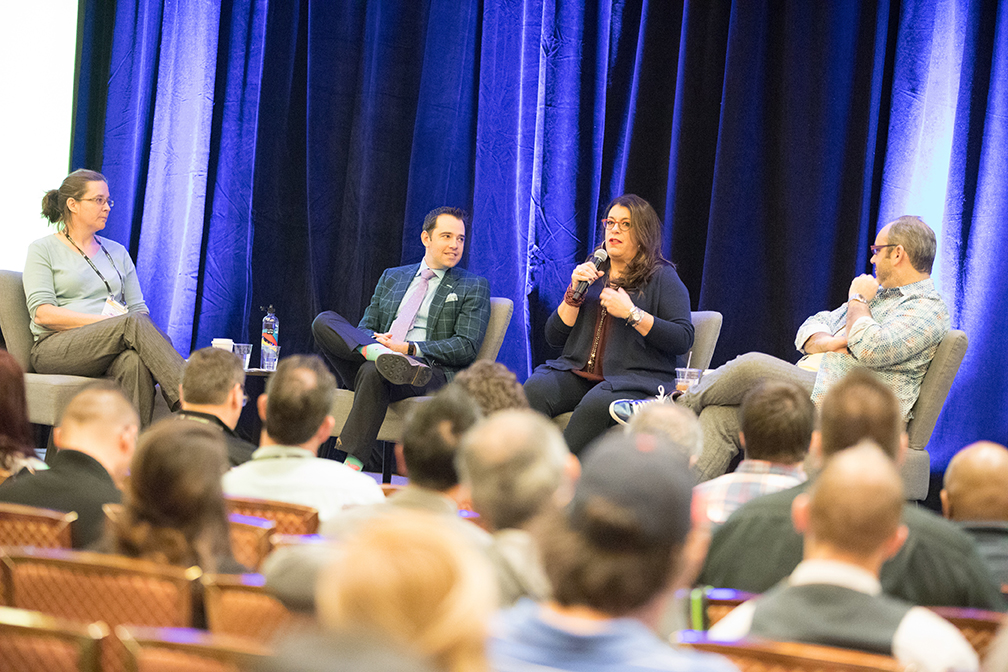At Catersource 2018 in Las Vegas, Bill Hansen, CEO, Bill Hansen Luxury Catering, moderated a panel consisting of small, medium, and large scale caterers for insight based on their own successful experiences, as well as the hard knocks they learned throughout their catering careers. Seated on the “Hidden Money” opening day panel at Caesars Palace were:
• Jeffrey Selden, Managing Partner, Marcia Selden Catering
• Robin Selden, Managing Partner/Executive Chef, Marcia Selden catering
• Anthony Lambatos, Owner, Footers Catering
• Abbey Duke, Founder/CEO, Sugarsnap
Want to learn proven ways to grow sales? Click here to be taken to last month’s article.
Here is a recap of that session.

Panelists Abby Duke, Anthony Lambatos, Robin Selden, Jeff Selden
QUESTION: What one cost-cutting idea worked the best for you?
Abbey Duke: Our biggest challenge is labor costs. We have started purchasing more lightly processed raw ingredients.
Anthony Lambatos: It’s not “cost cutting” per se, but a couple years ago we did an audit of our pricing and how we were charging and realized our sales team was not using the correct formulas for menu pricing. In terms of true cost-cutting, joining a group purchasing organization has had the biggest impact on our company in terms of cost savings.
Jeffrey Selden: We signed up with a great food purchasing company through the ICA and saved us tons of money.
QUESTION: What cost cutting idea backfired, and why?
Abbey Duke: Decreasing kitchen labor too much during slow weeks. Makes it hard to handle pop-up orders and it’s harder to keep staff.
Anthony Lambatos: Incentivizing people too heavily on reducing food and or labor costs. While it’s good to lower these numbers, sometimes it can go too far, and quality can begin to deteriorate.
Jeffrey Selden: We changed out some of our liquor offerings to lesser brands and then realized that our clients are very discerning and did not want to skimp on their favorite brands and/or cost when it came to their bars.
QUESTION: How do you handle last minute pop-up events and holiday season events to keep your costs and inventories under control?
Abbey Duke: We have designed our drop-off menu to have many items that can be kept in our freezer inventory. Our kitchen team then keeps our sales team informed about what they can sell for pop-ups.
Anthony Lambatos: Ask them if they can be flexible with their menu. If they are willing to do chef’s choice for all or part of the menu, we will prepare a similar menu to other events we are doing on that day.
Jeffrey Selden: Last minute events are handled like every other event. However, we think of them slightly differently in terms of minimums to ensure that are not hurting the production and setup of another existing event. We impose and imbed a minimum to make things work out (for example, a last-minute dinner party that for 20 may price at $100 per person, but I may decide that I want $2500 as a minimum so I would simply price at $125 per person). If it books, great—and if not, then I pass.
QUESTION: Give us one solid tip for controlling your variable labor costs.
Abbey Duke: Incentives for the onsite event manager to keep labor appropriate: setup and breakdown faster; cut staff when not needed, etc.
Anthony Lambatos: Write and keep a schedule each week and it should reflect the sales for that week.
Jeffrey Selden: Pay everything to the minute on events (if they are scheduled for 8 hours and only work 7.75 hours—we do not round up).
"We are part of a group purchasing organization. The economics of buying in larger quantities drives prices down. We also do batch production of many of our hors d’oeuvres."
QUESTION: Share one secret that saves money in your food purchasing.
Abbey Duke: We use an app called Orderly that helps track pricing. We also use it for monthly inventory. We recently moved from quarterly to monthly inventory and that is helping.
Anthony Lambatos: We are part of a group purchasing organization. The economics of buying in larger quantities drives prices down. We also do batch production of many of our hors d’oeuvres.
Jeffrey Selden: I don’t do our food purchasing…but our new company/contract with US Foods has saved us money.
QUESTION: What is one way you find hidden money when you do your budgeting?
Abbey Duke: I assign staff to each category and have them dig into it and find savings. For example: linens, cleaning supplies.
Anthony Lambatos: Shop your top expenses on a regular basis. We will usually pick two to three to do each year and do a deep dive on what we are purchasing to see if there are other options.
Jeffrey Selden: I embed parking, travel, and credit card fees into the hourly wages that we charge for staff to clients, so I don’t have to show/explain that to our clients that we are adding those costs.
QUESTION: Give an example of how someone stole from your company and what you changed to not allow that to happen again.
Abbey Duke: We had an issue with the cash after a cash bar being less than expected. Now, we inventory the alcohol that goes to an event and what comes back.
Anthony Lambatos: We also no longer allow employees to purchase food for personal use through the business.
Jeffrey Selden: We found that people were regularly taking leftovers and extra scrap food home and just thought it was OK. When we realized, we put a stop to that, installed cameras everywhere, and reviewed with the team that those items are saved for staff/crew meals.
QUESTION: What have you done to do more with less labor?
Abbey Duke: We are a scratch kitchen, but sometimes buying certain items saves a lot of time without sacrificing quality. We aim to have our core staff specialize in certain areas, but at the same time be cross trained so that they can help out when needed.
Anthony Lambatos: Hire people that can fill multiple roles. This allows us to hire a full-time employee, keep them during the slow season, and reduce turnover and re-training costs.
Jeffrey Selden: Hire interns!
"Each department has measurable objectives that all employees help to set related to revenue, cost control, customer satisfaction, and employee retention. We work to relate our daily work back to these objectives (and the strategies for achieving them)."
QUESTION: Employees who are not engaged workers cost you money. What do you do to keep your team members engaged?
Abbey Duke: Each department has measurable objectives that all employees help to set related to revenue, cost control, customer satisfaction, and employee retention. We work to relate our daily work back to these objectives (and the strategies for achieving them).
Anthony Lambatos: Constantly talking about our “why,” tying their work to our end product. We also ask for (and listen to) their input and suggestions on how to make our company better. We do numerous things throughout the year to create a fun work environment.
Jeffrey Selden: We have setup a loyalty program that has worked really well. Every comment from a client and captain/lead chef about a particular employee gains them points that they can use for Marcia Selden swag…and they LOVE IT! Also create a fun working environment to hopefully keep them interested in the work environment.
"We try and be as transparent as possible with the job descriptions and really map out exactly what the expectations are. We also create incentives for every associate in the building to keep them!"
When hiring, what procedures do you use to reduce the likelihood of turnover?
Abbey Duke: We often do work trials for kitchen help or delivery drivers. We try to hire off of referrals from current employees as much as we can for on-call staff.
Anthony Lambatos: We use an extensive process that involves multiple members of our company. We also use a job fit assessment that has been extremely valuable for us.
Jeffrey Selden: We try and be as transparent as possible with the job descriptions and really map out exactly what the expectations are. We also create incentives for every associate in the building to keep them! Value added benefits.
QUESTION: What systems do you use to monitor your revenues and costs during the month to keep you up-to-date and not be surprised with poor financial results?
Abbey Duke: I have a dashboard that I update every two weeks. Two weeks is a pay period. I have about 10 key metrics that are updated by the two-week period and the YTD and how they compare to last year. I also update the booked business and payroll and COG targets for the next two 2-week periods. By following this, there are no surprises.
Anthony Lambatos: Weekly forecasting can be done through our software and that is used to budget labor and food purchases. We also track our projections each month, so we know far in advance what the month will look like.
Jeffrey Selden: Monthly accounting meeting to review numbers and see where we are with expenses, revenues, and cash flow.
QUESTION: How do you keep tabs on employee credit card spending?
Abbey Duke: We only have one credit card number and employees must get permission to use it and then give me the receipt.
Anthony Lambatos: All receipts must be turned in and the statement is reviewed by both myself and our controller.
Jeffrey Selden: It’s tricky! Everyone needs our signature on any reimbursable.
QUESTION: How do you account for the cost of tastings and freebies?
Abbey Duke: I don’t really. That is one of my financial tracking goals for 2018, figure out how to do this!
Anthony Lambatos: We consider it part of our food cost. We feel that it is important for those marketing expenses to be wrapped into the overall big picture.
Jeffrey Selden: We account for them in our party budgets in how we charge by adding percentages to the parties if we know there will be added expenses like these.
Catersource 2019 will open its registration in September 2019. Click here for the latest information!



